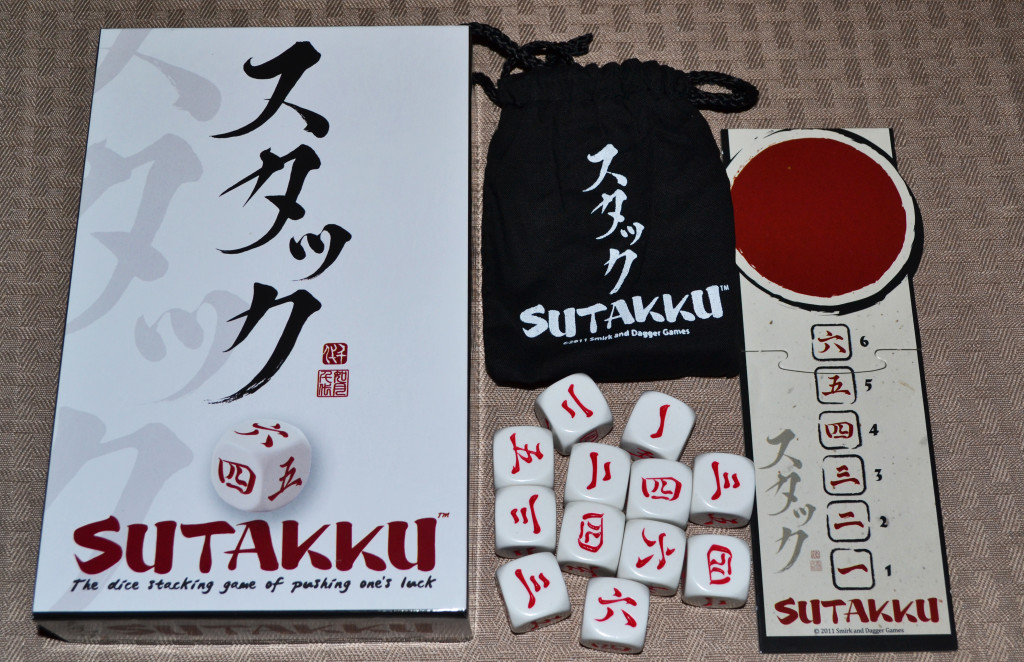“Sutakku” (meaning “stack” in Japanese) is a push-your-luck dice-stacking game. Players will be tasked with rolling dice with the intent on creating stacks…the taller the stack, the more points that are awarded. Players can stop at any time and score what they’ve just stacked, or opt to keep going in the hopes of pulling ahead of their competition. Like other push-your-luck games, it’s possible to get too greedy and fail, wiping away all your hard work (i.e. luck) up to that point. Before we get into the specifics, I’d like to thank Curt Covert from Smirk and Dagger for providing me with a free press copy for review purposes.
Components
The game includes 12 large dice, 1 black cloth bag, 1 stacking board, and a scorepad.
Setup & Gameplay
There’s really not a whole lot to do in order to set up the game…just place the dice and stacking board within easy reach of all players and assign someone to be the scorekeeper.
On a player’s turn, they’ll roll three dice (taking from the ones currently not already on the stacking board). Their goal is to have at least two of those dice show values that are equal to or greater than the die on top of the stack. Said dice are then placed on the stack in ascending order. For the first roll of the turn, players simply place two of the three dice onto the stacking board.
As a quick example, if the value on top of the stack is “3”, then two of the rolled dice must be valued at “3” or above. If the player rolled a “1”, “3”, and “5”, then the player must put the “3” on the stack first, then the “5”.
Once a player is done stacking, they can decide to keep going or stop and score. The higher the number on top of the stack, the more difficult it becomes to satisfy the roll check. To score, the player takes the value of the number on top of the stack and multiplies it by the number of dice in the stack. Bonus points are awarded for successfully stacking dice on fives and sixes, as well as stacking all twelve dice.
Some other things to note: mulligans are available (once per round) should the player roll unfavorably. This involves the player discarding one die and rolling the other two. Both dice must be able to be placed on the stack or the turn is over. Also, rolling doubles (3, 4, 4) allows you to place all three dice onto the stack instead of just two. Rolling a triple allows you to place all three as well…if it’s not legal, then you can re-roll all three dice for free.
The game is played over a series of rounds and the player with the most points at the end of it all, wins!
Editor’s Note: The above doesn’t cover all of the rules found in the manual, but should give you an idea as to how the game is played.
The Review
The dice themselves are fairly large, which is a plus for people like me who have trouble seeing across moderate to far distances. While the numbers on said dice are represented by Japanese symbols, it won’t take long to get accustomed to what they mean (there’s also a guide on the stacking board should you forget). The stacking board itself really isn’t necessary as you can stack the dice anywhere you please, though it does add to the theme rather nicely. The cloth bag is a convenient means to make the game portable, though the whole package is more than small enough to fit inside a suitcase or what have you. As a quick aside, I loved how there was a copy of the score-sheet on the back of the manual should you need to make more copies.
As a bonus (and not listed in the manual), the game came with a bonus deck of cards that can be used to make your opponents’ lives a little bit tougher. For example, the “Mountain’s Wrath” card challenges whoever it’s played on to have three sequential numbers in their tower that turn or they bust. On the plus side, these challenges often reward bonus points if the roller overcomes the odds. These cards are purely optional, but can spice things up a bit if you tire of the base game. Even with the challenges enabled, I don’t agree with the 14+ age requirement on the box…it should be around 8+, in my opinion.
I’ve seen the game advertised as something based around Japanese Folklore…specifically, “Sutakku was originally developed to teach the common man the foibles of wishing for more than he had.” While it is a valid lesson/moral, the same could be said for any push-your-luck game out on the market. That’s exactly what you’re getting here…a push-your-luck dice-rolling game. To that end, anyone who has played and enjoyed “Yahtzee” or “Farkle” may very well enjoy this one too. The price of $12-15 on Amazon (as of 7/21/15) is fair considering how large the dice are, the number of dice you’re getting, and the top-notch quality work that went into constructing said dice.
Final Verdict: 8/10
—


